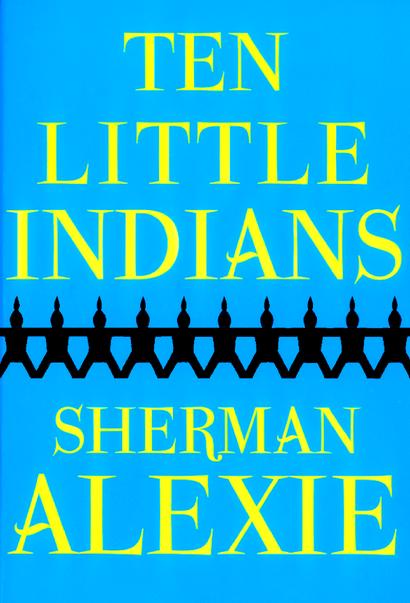Alexie's novels—especially Reservation Blues—have been well-received, and he's a blistering good poet as well. He's a crack performer, too, as evidenced by the fact that he won the title of World Heavyweight Champion Poet four years in a row at the Taos Poetry Circus. He would still be champ if he hadn't retired from the competition to give other poets a crack at the title.
Alexie's greatest literary strength, though, may well be his short stories. Collections like The Lone Ranger and Tonto Fistfight in Heaven and The Toughest Indian in the World are loaded to the gills with tiny masterpieces. While he's always explored a broad fictional range, Alexie's earlier stories often tended to focus on the lives of down-and-out reservation Indians. In his latest collection, Ten Little Indians, released last month, Alexie has shifted focus.
This time out, most of his Indian protagonists don't live on the reservation, and they aren't down on their luck either. Ten Little Indians tells nine crisp tales focusing entirely on urban Indians, most of whom, much like Alexie himself, have achieved a large degree of success in mainstream American society. They're bright college students, ambitious politicos and businessmen in pin-striped suits at the very top of their game.
At the same time, the characters in Ten Little Indians fit in well with characters from Alexie's earlier fiction. From the very beginning of his career, this writer never resorted to Indian stereotypes, as even Indian authors sometimes have a tendency to do. There's no noble savage bullshit polluting his stories. That's what's always made his fiction so bloody brilliant, and that's what makes Ten Little Indians a rock solid collection of ingenious storytelling.
In “Do You Know Where I Am?” Alexie spins a thunderstorm of a story about two young Indian soul mates and a pair of deceptions that threaten to split them apart. This tale shows off Alexie's enormous yarn-spinning talents at their finest. The lyrical conclusion packs the kind of emotional punch that most writers can only dream about.
In “Lawyer's League” a young, half Black, half Indian, up-and-coming Democratic Party functionary ends up clocking a white supremacist lawyer on a basketball court. Here Alexie is blunt and visceral. After all, it's hard not to enjoy the image of a loudmouth white racist getting knocked on his ass. Even in this story, though, Alexie plays with racial subtleties when the protagonist considers and ultimately dismisses the idea of starting a relationship with a white woman because he knows it would hurt his career.
My favorite story in the collection, “Do Not Go Gentle,” describes the agony of two young Indian parents whose suffocating baby boy winds up in the hospital on life support. At the end of his wits, the father enters a store called Toys in Babeland in search of a present for his dying son. The toy store, though, doesn't sell stuffed animals, rubber balls or toy cars. It's not that kind of toy store. Instead, this store carries life-size blow-up blondes, flavored lubricants, sexy videos and vibrators.
The father goes a little crazy and buys a giant dark brown 15-inch vibrator called Chocolate Thunder. Bringing the “toy” back to the hospital, he uses it as sacred medicine—singing, dancing, laughing and waving that strange talisman over his sick baby and all the other sick babies. His wife picks up Chocolate Thunder and bangs on her hand drum with it. “Do Not Go Gentle” is a ludicrous but beautiful story describing a spiritual window opened by raw grief.
Not every story in the collection deals with well-heeled Native Americans. One of the better tales, “What You Pawn I Will Redeem,” is about a homeless drunkard who comes across his grandmother's powwow regalia in the window of a pawnshop. This story is a brutal, funny and convincing portrait of life on the streets of Seattle.
The goal of all artists, literary artists in particular, is to expose and celebrate the complexity of human nature. In exposing American Indians in all their diversity, Alexie has accomplished this as well as anyone. The Indians in his stories are living, breathing, flawed people. His characters are just as capable of love, hate, beauty and ugliness as the rest of us. In that sense, Alexie's stories do us a great service: They build bridges between alienated, conflicted groups of people, making understanding, friendship and ultimate reconciliation in the shadow of this country's horrible past, if not likely, at the very least imaginable.









